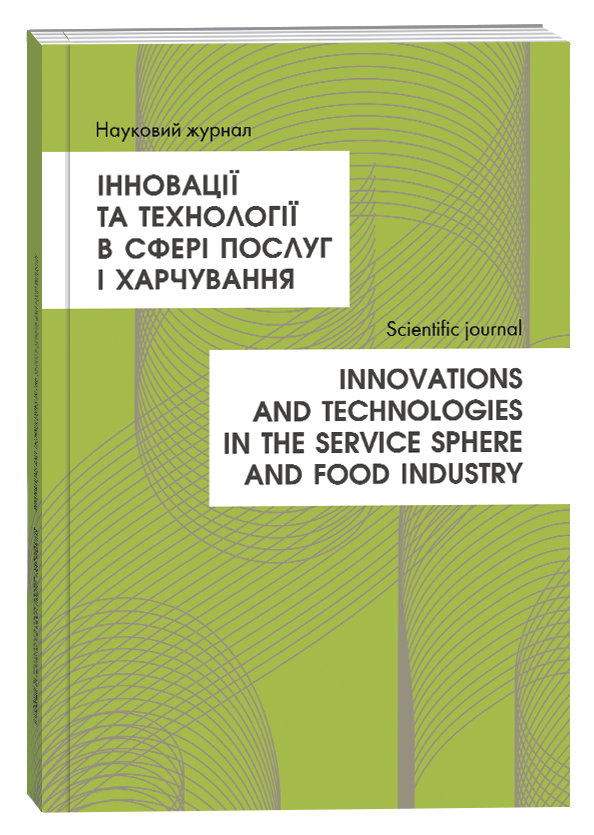STUDY OF THE NUTRITIONAL VALUE OF GLUTEN-FREE BREAD BASED ON GREEN BUCKWHEAT ENRICHED WITH QUINOA SEEDS
Abstract
In modern conditions, there is an increase in demand for gluten-free bakery products, which is explained both by the spread of celiac disease and gluten intolerance, and by the growth of a conscious approach to healthy eating among the population. Increasing the nutritional value of such products is of particular importance in the bakery industry. Gluten-free bread should not only serve as a dietary product, but also contribute to the overall health of the body, expanding its impact on maintaining health. The nutritional value and quality of gluten-free bread based on green buckwheat groats with the addition of quinoa seeds in proportions of 5, 10 and 15% of the total mass of raw materials were studied. The study was aimed at improving the recipe and optimizing the technological process for the production of gluten-free bakery products with improved nutritional and organoleptic characteristics. It was found that the addition of quinoa significantly increases the nutritional value of the product. In particular, the protein content increased from 7.57 g in the control sample to 13.58 g in the experimental variants, fats from 4.61 g to 13.20 g, and dietary fiber from 5.88 g to 8.68 g. In addition, a significant enrichment of the product with minerals (potassium, calcium, magnesium, phosphorus) and an increase in the vitamin complex by 130–150% were observed. The energy value of the studied products increased to 338 kcal, which meets the requirements of a balanced diet. Particular attention was focused on the assessment according to the Nutri-Score system, according to which all the studied samples received the highest category A. This indicates their compliance with modern standards of healthy nutrition and significant potential for practical use. The results obtained confirm the prospects of using green buckwheat as a basic raw material for gluten-free products and prove the feasibility of enriching it with functional ingredients of plant origin. The research conducted lays the foundation for further development of new types of gluten-free bread with improved consumer properties and increased biological value, which corresponds to modern trends in healthy eating.
References
Singh, P., & Whelan, K. Limited availability and higher cost of gluten-free foods. Journal of Human Nutrition and Dietetics. 2011. Vol. 24. № 5. P. 479–486. DOI: https://doi.org/10.1111/j.1365-277X.2011.01160.x
Saturni, L., Ferretti, G., & Bacchetti, T. The gluten-free diet: Safety and nutritional quality. Nutrients. 2010. Vol. 2. № 1. P. 16–34. DOI: https://doi.org/10.3390/nu2010016
Moroni, A. V., Dal Bello, F., & Arendt, E. K. Sourdough in gluten-free bread-making: An ancient technology to solve a novel issue? Food Microbiology. 2010. Vol. 27. № 5. P. 749–756. DOI: https://doi.org/10.1016/j.fm.2010.05.003
Vega-Gálvez A., Miranda M., Vergara J., Uribe E., Puente L., & Martínez E. Nutrition facts and functional potential of quinoa (Chenopodium quinoa willd.), an ancient Andean grain: A review. Journal of the Science of Food and Agriculture. 2010. Vol. 90. № 15. P. 2541–2547. DOI: https://doi.org/10.1002/jsfa.4158
Catassi C., & Fasano A. Celiac disease diagnosis: Simple rules are better than complicated algorithms. American Journal of Gastroenterology. 2022. Vol. 117. № 1. P. 15–17. DOI: https://doi.org/10.14309/ajg.0000000000001568
Capriles V. D., & Arêas J. A. Novel approaches in gluten-free breadmaking: Interface between food science, nutrition, and health. Comprehensive Reviews in Food Science and Food Safety. 2014. Vol. 13. № 5. P. 871–890. DOI: https://doi.org/10.1111/1541-4337.12091
Banu I., & Aprodu I. Assessment of the Performance of Oat Flakes and Pumpkin Seed Powders in Gluten-Free Dough and Bread Based on Rice Flour. Applied Sciences. 2024. Vol. 14. № 8. P. 3479. DOI: https://doi.org/10.3390/app14083479
Wójcik M., Dziki D., Matwijczuk A., et al. Walnut Flour as an Ingredient for Producing Low-Carbohydrate Bread: Physicochemical and Sensory Evaluation. Foods. 2023. Vol. 12. № 17. P. 3320. DOI: https://doi.org/10.3390/foods12173320
Del Vecchio L., et al. Hemp flour in breadmaking: circularity and opportunities for food systems. European Food Research and Technology. 2025. Vol. 251. № 6. P. 1047-1060. DOI: https://doi.org/10.1007/s00217-025-04687-0
Moroni A. V., Dal Bello F., & Arendt E. K. Biodiversity of lactic acid bacteria and yeasts in buckwheat and teff gluten-free sourdoughs. Food Microbiology. 2011. Vol. 28. № 3. P. 438–447. DOI: https://doi.org/10.1016/j.fm.2010.10.009
Arendt E. K., Ryan L. A. M., & Dal Bello F. Medical nutrition therapy: Use of sourdough lactic acid bacteria to reduce gluten exposure. Microbial Cell Factories. 2011. Vol. 10. № 1. P. 15. DOI: https://doi.org/10.1186/1475-2859-10-S1-S15
Różyło R., et al. Effect of adding fresh and freeze-dried buckwheat sourdough on gluten-free bread quality. International Journal of Food Science & Technology. 2015. Vol. 50. № 10. P. 2390–2397. DOI: https://doi.org/10.1111/ijfs.12622
Васьківська А., & Пересічна С. Харчова цінність бездріжджового безглютенового хліба. Інновації та технології в сфері послуг і харчування. 2023. Вип. 3; № 9. С. 5-12. DOI: https://doi.org/10.32782/2708-4949.3(9).2023.1
International Agency for Research on Cancer. The Nutri-Score: An evidence-based front-of-pack nutrition label for Europe. Lyon: IARC, 2021. URL: https://www.iarc.who.int/wp-content/uploads/2021/09/IARC_Evidence_Summary_Brief_2.pdf (дата звернення: 05.09.2025).
Foodwatch. Nutri-Score: how to use a label to improve health and diet. – Foodwatch International, 2022. URL: https://www.foodwatch.org/en/nutri-score-how-to-use-a-label-to-improve-health-and-diet (дата звернення: 05.09.2025).
Singh P., & Whelan K. (2011). Limited availability and higher cost of gluten-free foods. Journal of Human Nutrition and Dietetics, no. 24(5), pp. 479–486. DOI: https://doi.org/10.1111/j.1365-277X.2011.01160.x
Saturni L., Ferretti G., & Bacchetti T. (2010). The gluten-free diet: Safety and nutritional quality. Nutrients, no. 2(1), pp. 16–34. DOI: https://doi.org/10.3390/nu2010016
Moroni A. V., Dal Bello F., & Arendt E. K. (2010). Sourdough in gluten-free bread-making: An ancient technology to solve a novel issue? Food Microbiology, no. 27(5), pp. 749–756. DOI: https://doi.org/10.1016/j.fm.2010.05.003
Vega-Gálvez A., Miranda M., Vergara J., Uribe E., Puente L., & Martínez E. A. (2010). Nutrition facts and functional potential of quinoa (Chenopodium quinoa willd.), an ancient Andean grain. A review. Journal of the Science of Food and Agriculture, no. 90(15), pp. 2541–2547. DOI: https://doi.org/10.1002/jsfa.4158
Catassi C., & Fasano A. (2022). Celiac disease diagnosis: Simple rules are better than complicated algorithms. American Journal of Gastroenterology, no. 117(1), pp. 15–17. DOI: https://doi.org/10.14309/ajg.0000000000001568
Capriles V. D., & Arêas J. A. G. (2014). Novel approaches in gluten-free breadmaking: Interface between food science, nutrition, and health. Comprehensive Reviews in Food Science and Food Safety, no. 13(5), pp. 871–890. DOI: https://doi.org/10.1111/1541-4337.12091
Banu I., & Aprodu I. (2024). Assessment of the Performance of Oat Flakes and Pumpkin Seed Powders in Gluten-Free Dough and Bread Based on Rice Flour. Applied Sciences, no. 14(8), pp. 3479. DOI: https://doi.org/10.3390/app14083479
Wójcik M., Dziki D., Matwijczuk A., et al. (2023). Walnut Flour as an Ingredient for Producing Low-Carbohydrate Bread: Physicochemical and Sensory Evaluation. Foods, no. 12(17), pp. 3320. DOI: https://doi.org/10.3390/foods12173320
Del Vecchio L., et al. (2025). Hemp flour in breadmaking: circularity and opportunities for food systems. European Food Research and Technology, no. 251(6), pp.1047-1060. DOI: https://doi.org/10.1007/s00217-025-04687-0
Moroni A. V., Dal Bello F., & Arendt E. K. (2011). Biodiversity of lactic acid bacteria and yeasts in buckwheat and teff gluten-free sourdoughs. Food Microbiology, no. 28(3), pp. 438–447. DOI: https://doi.org/10.1016/j.fm.2010.10.009
Arendt E. K., Ryan L. A. M., & Dal Bello F. (2011). Medical nutrition therapy: Use of sourdough lactic acid bacteria to reduce gluten exposure. Microbial Cell Factories, no. 10(S1), pp. 15. DOI: https://doi.org/10.1186/1475-2859-10-S1-S15
Różyło R., et al. (2015). Effect of adding fresh and freeze-dried buckwheat sourdough on gluten-free bread quality. International Journal of Food Science & Technology, no. 50(10), pp. 2390–2397. DOI: https://doi.org/10.1111/ijfs.12622
Vaskivska A. & Peresichna S. (2023). Kharchova tsinnist bezdrizhdzhovoho bezhlyutenovoho khliba [Nutritional value of yeast-free gluten-free bread]. Innovatsiyi ta tekhnolohiyi v sferi posluh i kharchuvannya, no. 3 (9), pp. 5-12. DOI: https://doi.org/10.32782/2708-4949.3(9).2023.1
International Agency for Research on Cancer. (2021). The Nutri-Score: An evidence-based front-of-pack nutrition label for Europe. – Lyon: IARC, 2021. Available at: https://www.iarc.who.int/wpcontent/uploads/2021/09/IARC_Evidence_Summary_Brief_2.pdf (accessed 05.09.2025).
Foodwatch. (2022). Nutri-Score: how to use a label to improve health and diet. – Foodwatch International, 2022. Available at: https://www.foodwatch.org/en/nutri-score-how-to-use-a-label-toimprove-health-and-diet (accessed 05.09.2025).



